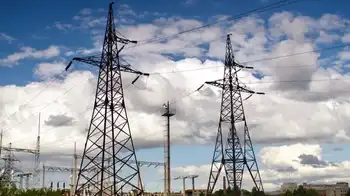Wisconsin's utility stocks enjoy a year of gains
By By Thomas Content - Milwaukee Sentinel-Journal
Protective Relay Training - Basic
Our customized live online or in‑person group training can be delivered to your staff at your location.

- Live Online
- 12 hours Instructor-led
- Group Training Available
Electric and natural gas utilities enjoyed a year of recovery, rebounding from years of uncertainty when energy markets sank and Enron and other power-plant builders went bankrupt.
Mid-size utility stocks gained 14 per cent in 2004, and most of the Wisconsin investor-owned utilities shared in those gains. The stock prices of the two Madison-based utilities, MGE Energy Inc. and Alliant Energy Corp., were each up 15 per cent. Green Bay-based WPS Resources Corp. rose 8 per cent.
As 2005 dawns, analysts and investors remain bullish on the sector, even as some stocks, including WPS and Alliant, trade at or near 52-week highs.
The reasons: low inflation, low interest rates, increased regulatory certainty, rising demand for electricity and natural gas, even during the recent recession, and stronger balance sheets, say Ron Sorenson and Kathleen Vuchetich of W.H. Reaves & Co., a New Jersey investment research firm that specializes in utilities.
And donÂ’t forget dividends, now back in vogue.
“A few years ago, nobody cared about dividends,” said Sorenson, Reaves’ chief investment officer and portfolio manager. “But there’s enormous pressure right now on companies to institute dividends or take the cash they have on their balance sheets and give it to their shareholders through dividend increases.”
Across the nation, and particularly in Wisconsin, companies that lost money in unregulated businesses have discovered close-to-home opportunities in their primary businesses, the old-line electric and natural gas utilities that were out of favor during the technology boom.
The turnaround is sweet for the sector, with Merrill Lynch projecting that utilities will report 10 per cent earnings growth in 2005, outpacing tech-industry results.
A key concern for investors of Wisconsin utilities centers on two developments late in 2004 and the shadow they may cast this year, not only on energy policy but on the performance of Wisconsin utilitiesÂ’ shares.
The state Public Service Commission rejected the WPS and Alliant plan to sell the Kewaunee nuclear plant, and a Dane County judge vacated the order giving Wisconsin Energy Corp. permission to build a $2.15 billion coal plant project in Oak Creek.
Investors all but ignored the Kewaunee decision, expecting that the utilities will get their way on appeal. But they reacted to the Oak Creek decision, sending Wisconsin EnergyÂ’s shares down 2 per cent a day after the court ruling. The stock finished the year up 1%, at $33.71.
Coal-plant uncertainty is taking its toll on Wisconsin Energy shares, analysts agree. The stock is trading at a 5% discount to its peers, even though its growth prospects are much better, in part because of the coal project, said David Parker, a Florida-based investment analyst with Robert W. Baird & Co.
The project, along with a Port Washington natural gas plant, is the centerpiece of a corporate business strategy built around meeting growing demand for electricity in Wisconsin. All told, the four plants Wisconsin Energy hopes to build by 2010 are projected to expand its earnings base by 50 per cent.
Wisconsin EnergyÂ’s stock hasnÂ’t been hammered by the court ruling, analysts say, in part because investors sense either that the case will get resolved or that the utility will ultimately get permission to build more new plants.
The need for power plants in Wisconsin is so significant, analysts and investors say, that long-term investors need not worry about developments in the Oak Creek case.
“Wisconsin needs additional power generation,” said Ted Baszler, vice president at Heartland Advisors and manager of the Heartland Select Value Fund. “Regardless of whether or not it’s a coal-fired plant in Oak Creek, or some other gas-fired plant solution that might be more environmentally friendly, there are going to be plants that are built.”
John Kearney, an analyst with Morningstar, agreed.
“The thought is that Wisconsin has such a need for more capacity that investors just think that one way or another they’re eventually going to come out of this relatively healthy.”
Because of the financial terms of the coal-plant plan, Wisconsin Energy will be provided a guaranteed rate of return for 30 years from its investment in the new plants. Those growth prospects mean that the utility has “some of the best growth prospects” compared with other regulated utilities, Kearney said.
An end to the Oak Creek legal and regulatory roadblocks will be a key driver for the stock, Parker said.
“That’s very important,” he said. “Wall Street sort of waits to see the outcome before it’ll start bidding up a stock.”











